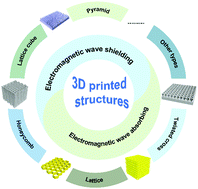Recent advances in 3D printed structures for electromagnetic wave absorbing and shielding
Abstract
The rapid development and widespread application of electronic devices and technologies have occurred in recent years, while they also bring an ever-increasing electromagnetic pollution threat to human beings’ health and device reliability. Electromagnetic wave shielding and electromagnetic wave absorption are considered the most effective solutions to address electromagnetic interference. Compared to common powder and bulk materials, self-supporting three-dimensional (3D) structures exhibit better prospects due to the pre-design structure with increased electromagnetic wave transmission paths and multiple reflections. 3D printed functional structures for electromagnetic wave absorbing and shielding have attracted extensive attention because of their capability for the fabrication of arbitrary shapes in a faster, cheaper and more flexible way. Especially, 3D printing technology can meet the personalized requirement of highly integrated and miniaturized next-generation electronic products for shape conformability. This review focuses on the latest evolution in the working principle, structure design, advanced additive manufacturing technologies and the typical applications of 3D printed structures for electromagnetic wave absorbing and shielding. The current challenges and future prospects are also suggested toward the development of most progressive 3D printed structures for electromagnetic wave absorbing and shielding, which indicate the trends and key points for future research.

- This article is part of the themed collection: 2022 Materials Chemistry Frontiers Review-type Articles


 Please wait while we load your content...
Please wait while we load your content...